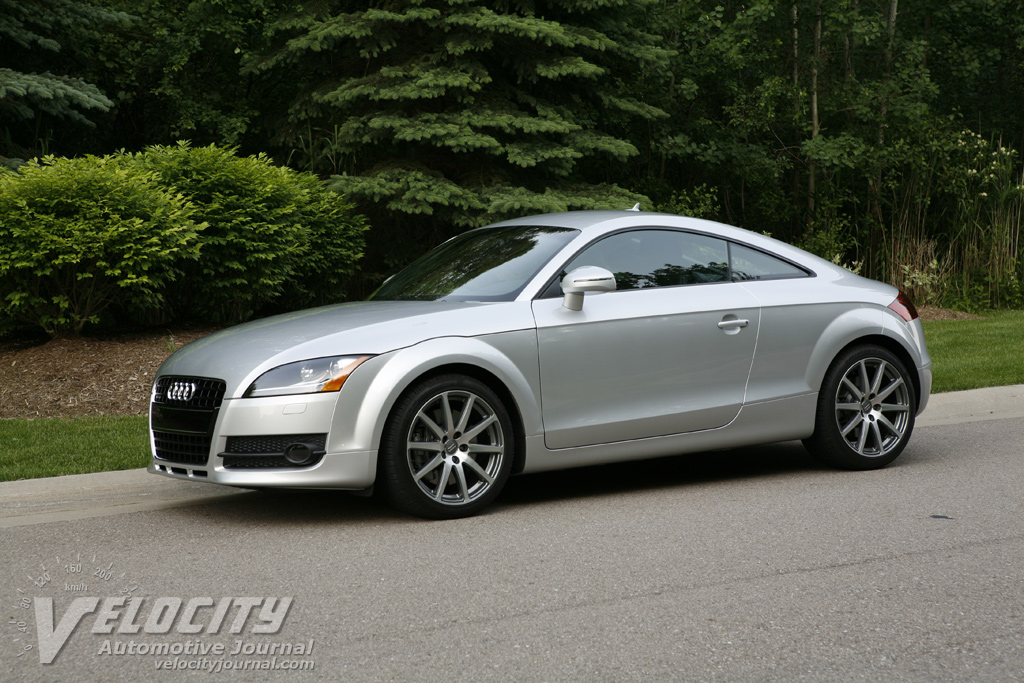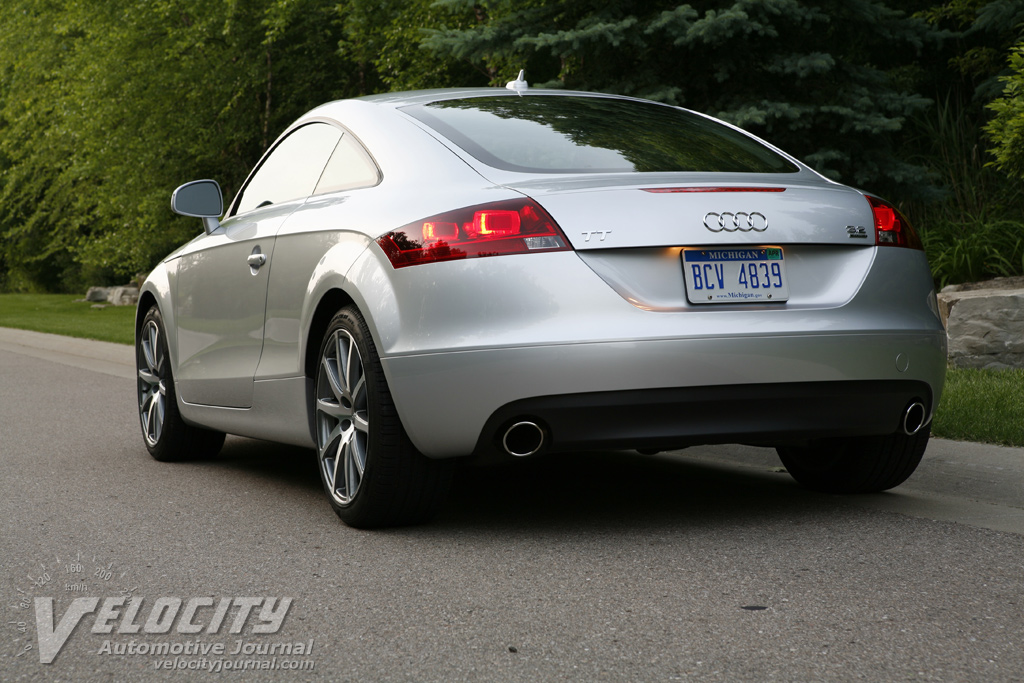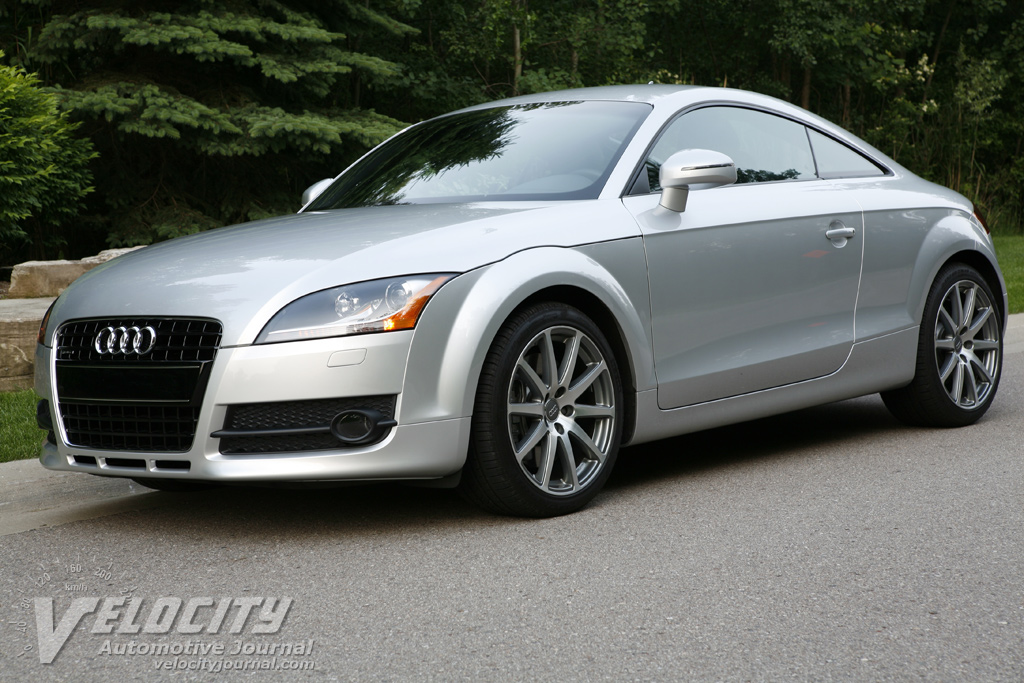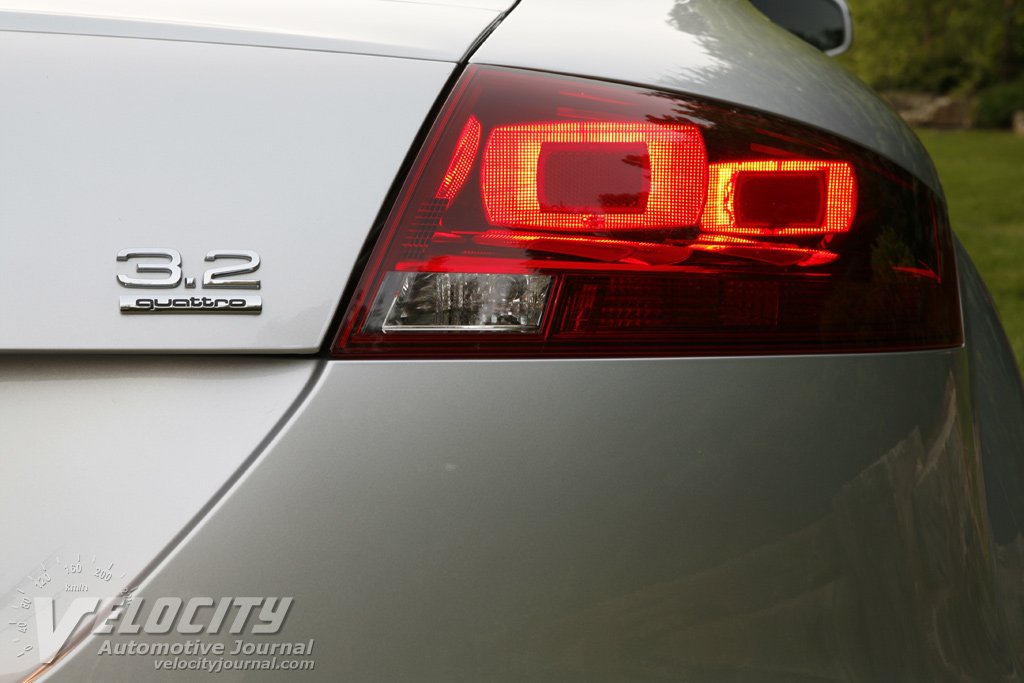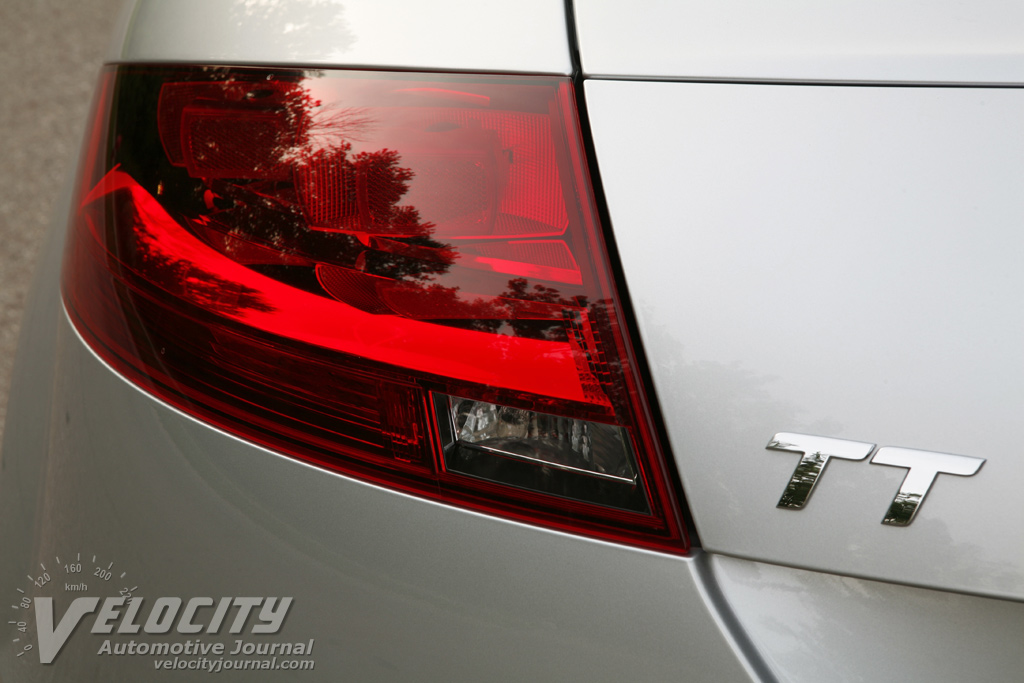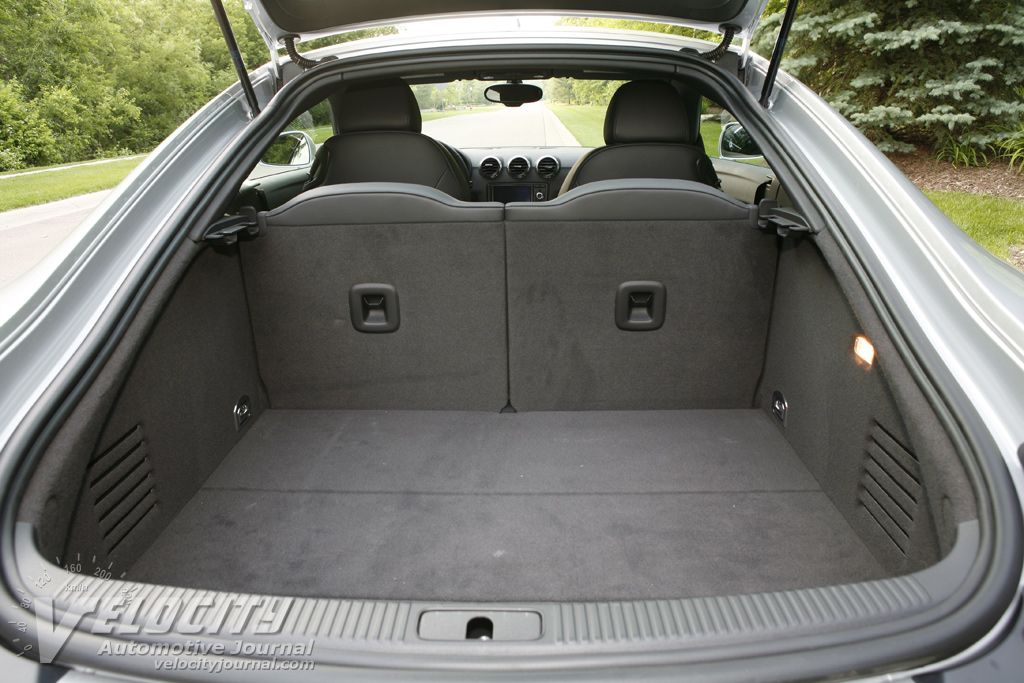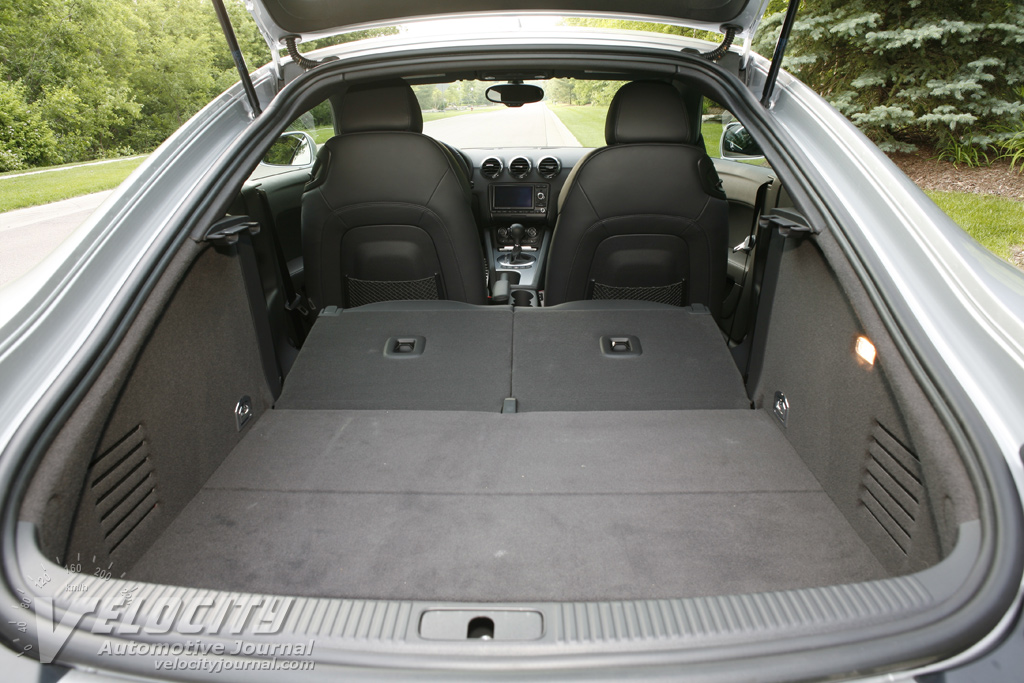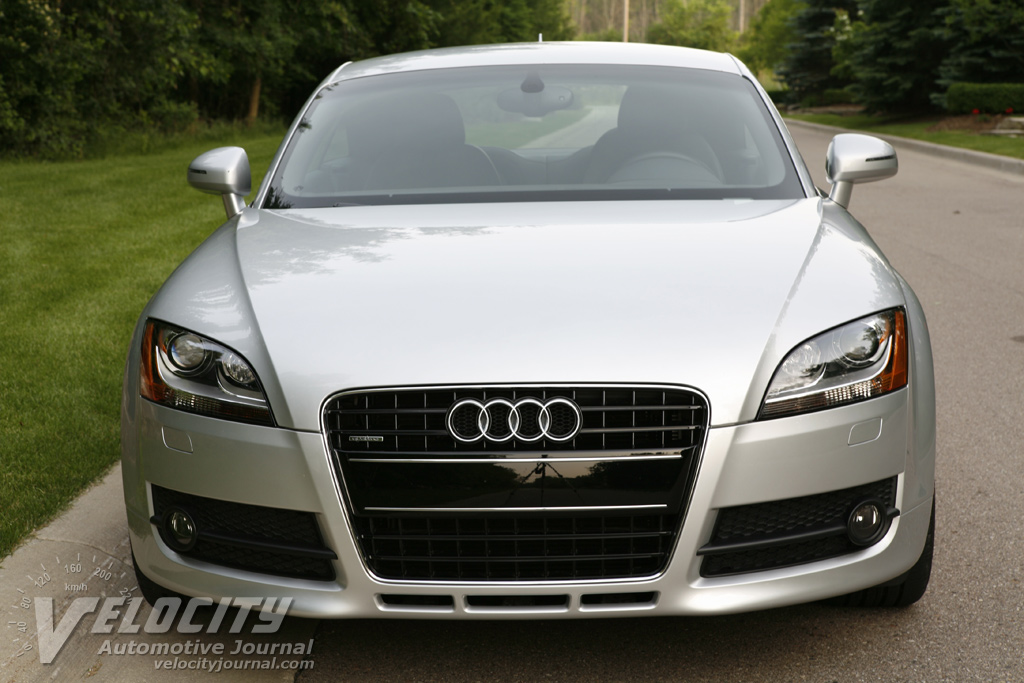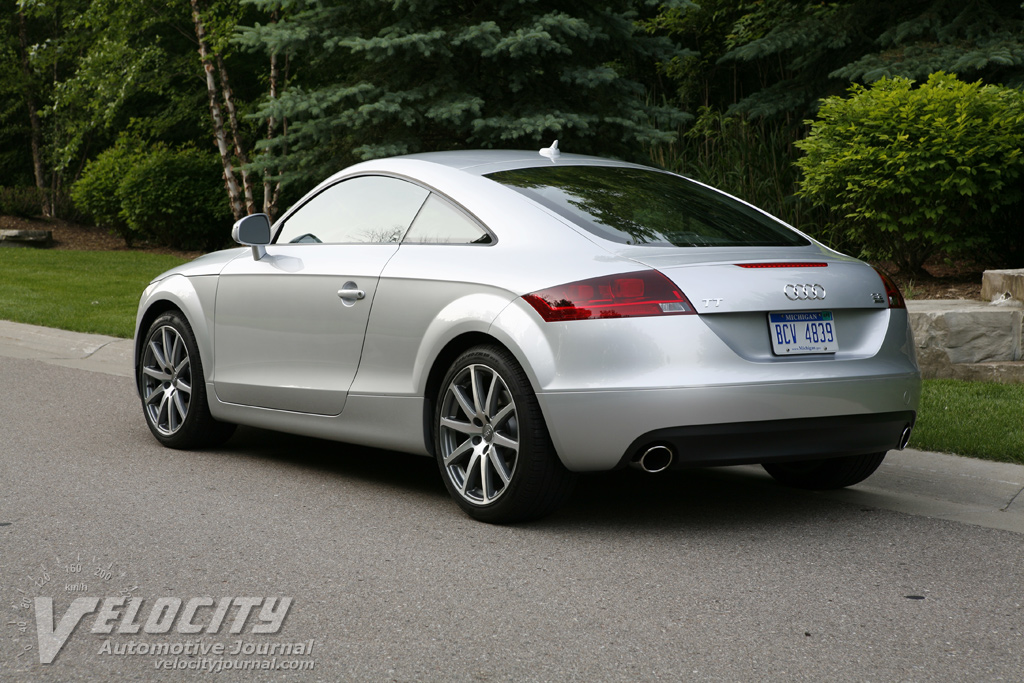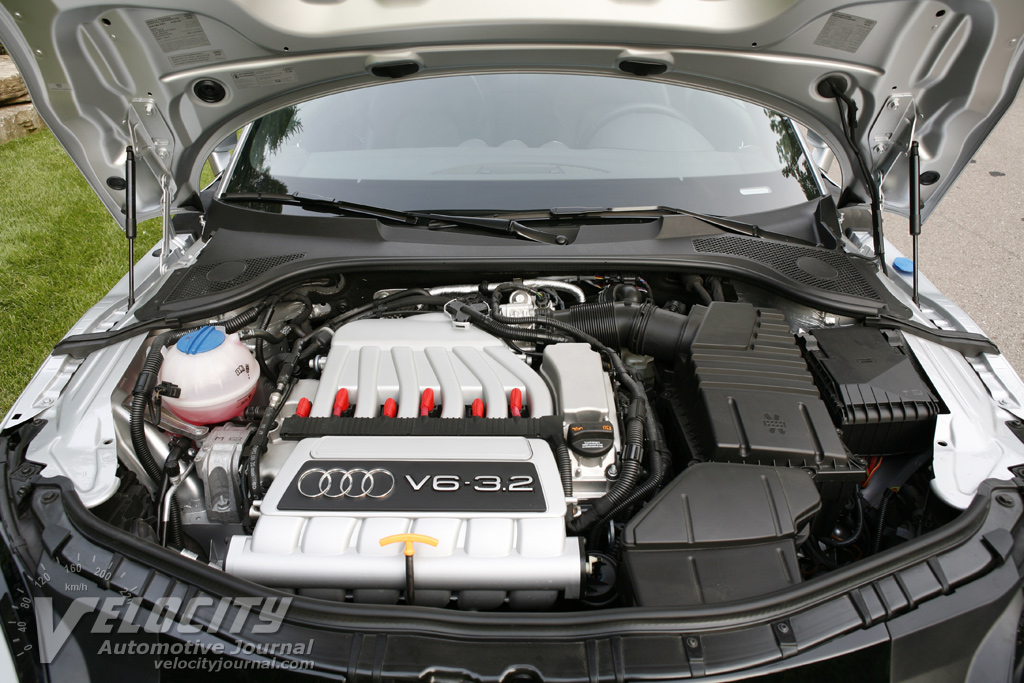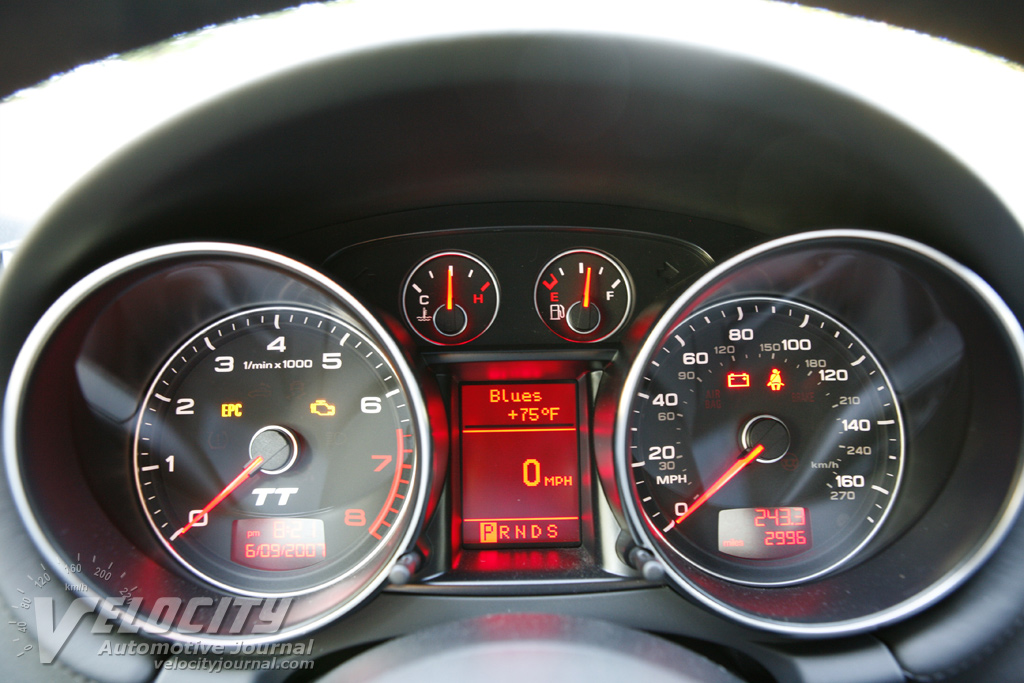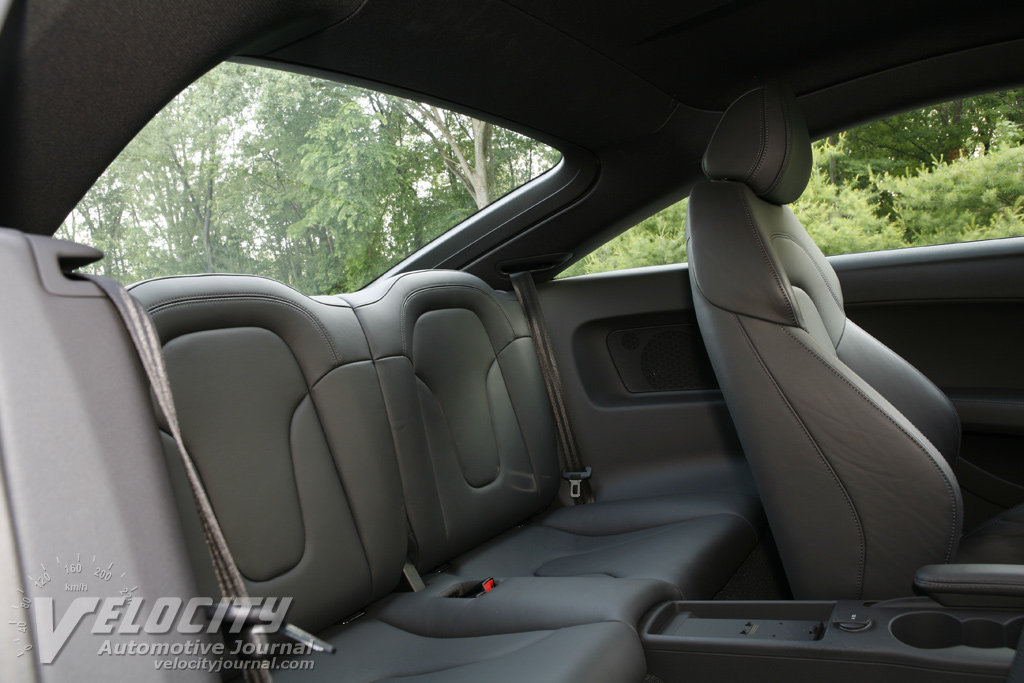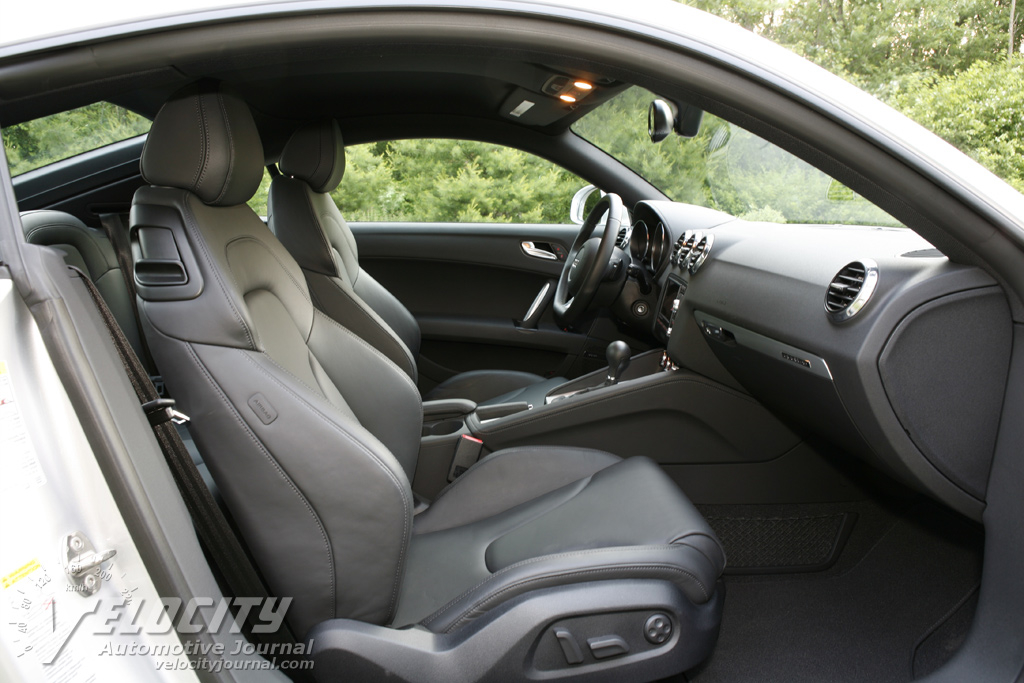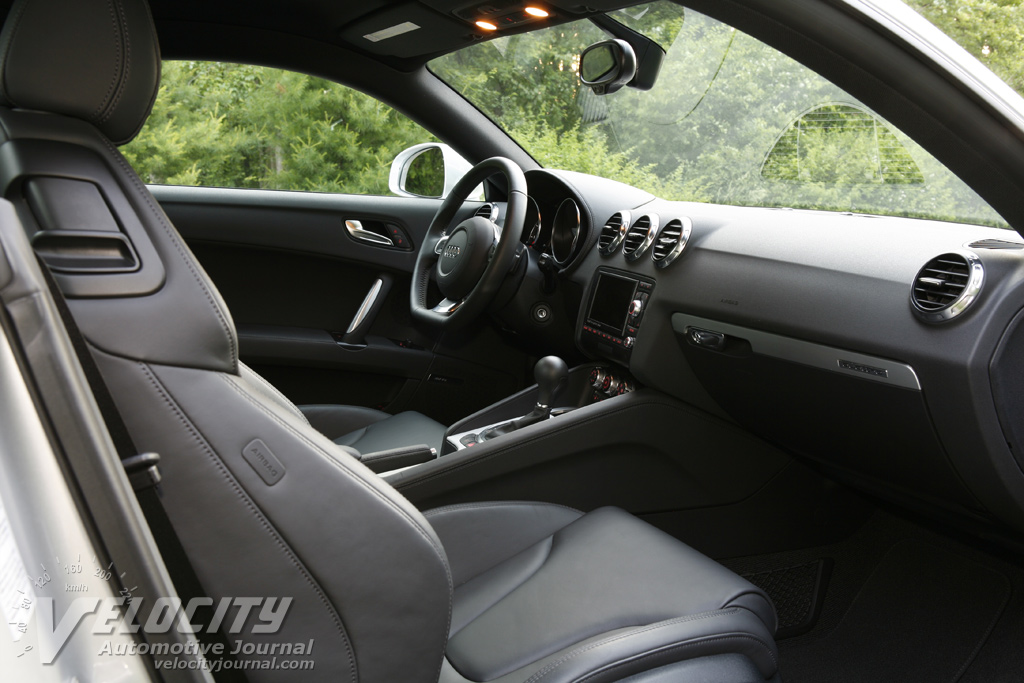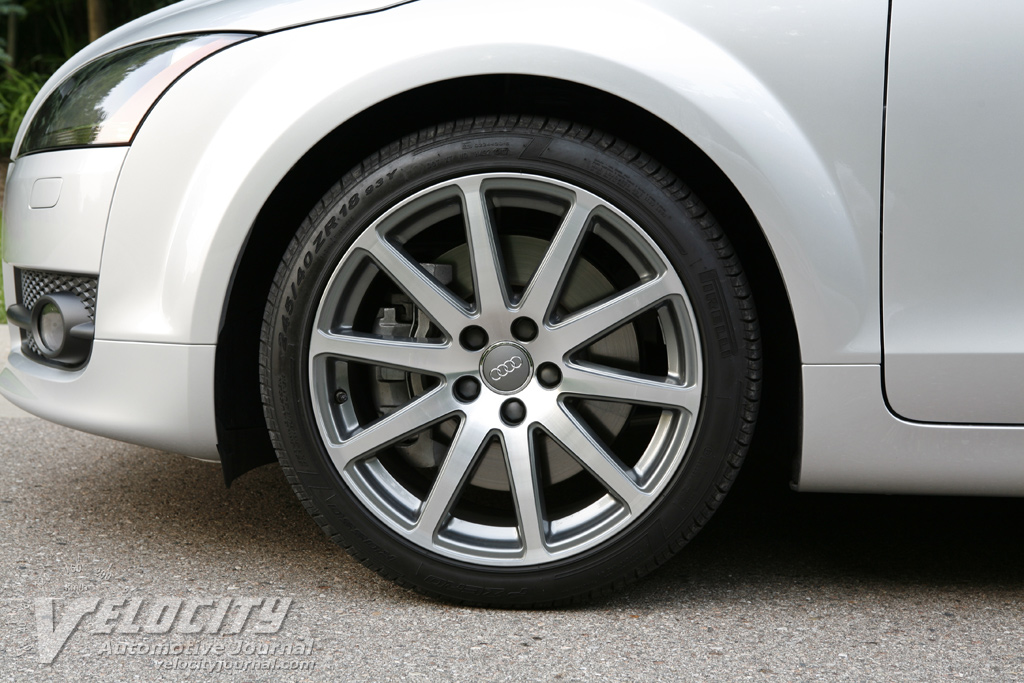2008 Audi TT Coupe 3.2 quattro S tronic
06/11/2007
Shahed Hussain
The first generation Audi TT debuted at the 1995 Frankfurt Motor Show. Despite its stunning styling, the TT was never considered a serious sports coupe, partly because of its humble Golf-based roots. Available initially with a 1.8L turbo, and later with a muscular 3.2L V-6, the TT struggled to overcome its image as a re-bodied Golf. Base TT models were FWD, which further undermined its credibility as a sports car; although available quattro® AWD did improve handling significantly. With competitors such as the newer BMW Z4, Mercedes-Benz SLK, and Nissan 350Z, the aging TT simply could not keep up with its more focused rivals.
Audi clearly wants the 2nd generation TT to be perceived as a no-excuses sports car, despite its continuing debt to the current generation Golf (Rabbit in the USA). For the redesigned 2008 TT, Audi tightened up the slightly bulbous curves, grafted on a scowling front fascia, and added redesigned taillights that evoke the new R8 coupe. The corporate 200-bhp 2.0L turbo is the base powerplant, driving the front wheels; while the optional 250-bhp 3.2L V-6 sends power to all four wheels via Audi's familiar quattro® AWD system. Both transversely mounted engines transmit power via a 6-speed S tronic dual-clutch gearbox (formerly called DSG), or a 6-speed manual (3.2 quattro only).
We tested a TT 3.2 quattro S tronic coupe equipped with several expensive option packages. Although the base price starts at $42,900, our test car had the Light Silver Metallic paint ($475), Audi Navigation Plus with iPod® interface ($1,950), Audi Magnetic Ride Suspension ($1,400), Enhanced Interior Package ($1,100), Audio Package ($1,000), 18-inch alloy wheels with summer performance tires ($800), Bi-Xenon Adaptive Headlights ($800), and Bluetooth® Phone Preparation package ($450). The grand total was an eyebrow-raising $51,595, including $720 destination charge. If we were buying the TT, we would skip the Audi Magnetic Ride Suspension, and the Bluetooth Preparation package, which would slice $1,850 off the sticker price to sneak in just under $50K. If the 6-speed manual is your preference, then you can chop another $1,400 from the bottom line. Unless you must have quattro, or want V-6 performance, the $36,950 front-drive 2.0 TFSI (with the Premium Package) is a better deal for the more frugal enthusiast.
Audi interiors are often used as benchmarks for other manufacturers, and the TT is no exception. Usually, we're not impressed with expensive interior upgrade packages, but we have to admit that the superb Nappa leather sport seats in the TT are worth the price. These seats have 10-way power adjustments to suit most physiques. Comfortable thigh and torso bolsters wrap around your body like a cocoon. Despite the 4-way power adjustment, we found lower lumbar support somewhat lacking. Reaching around for the seatbelts can be difficult for drivers shorter than 5'-8" because the belt attachment point is well behind the front seats. One might expect that the belts would clip to the seats, but that would impede access to the miniscule rear seats. With virtually upright backrests and almost nonexistent legroom, the rear seats are nearly unusable for adults. Audi even includes a sticker that requires a 1-inch clearance between rear passenger heads and the roofline; which essentially relegates the rear seats to small children or luggage. Fortunately, front headroom should be adequate for 6-foot tall passengers; but those taller than that will need to drop the seat height to keep from brushing up against the headliner. Once situated in the driver's seat, the flat bottom leather-wrapped steering wheel falls easily to hand.
Auxiliary controls for the optional Bose® audio system and Bluetooth® phone are integrated on the wheel spokes. Manually adjustable tilt and telescoping controls allow the driver to select the ideal wheel position. Inside the soft-touch instrument binnacle is an 8,000 RPM tachometer and 160-MPH speedometer. In between are smaller fuel and temperature gauges; as well as a red dot matrix display that shows selected transmission mode, vehicle speed, audio information, compass direction, nearest street, and outside temperature. Although the digital speed readout is redundant, Audi crammed essential information directly in front of the driver to minimize distraction.
The optional DVD navigation system has multiple buttons and knobs that aren't laid out very intuitively, so the owner's manual is required reading. Flip open the multi-function LCD panel to reveal a DVD slot and two SD card slots for MP3 audio files. A 12-speaker, 255-watt Bose audio system will please most audiophiles with its sound clarity. The triple knob HVAC controls echo the vents on the dash. Previous TT owners will appreciate these more usable controls, which require less fiddling to adjust temperature and fan settings. Alloy pedals are almost a requirement in sports coupes, and the TT does not disappoint: aluminum brake, accelerator, and a big dead pedal are arranged in a roomy footwell. The center console-mounted padded handbrake doubles as an armrest. Dual cupholders next to the handbrake are a concession to American preferences.
The 3.2L V-6 has a raspy exhaust note that sounds appropriate aggressive and sporty. With strong throttle response and a fat torque band (236 lb.-ft. @ 2,500-3,000 RPM), this popular V-6 never feels peaky. Power output remains competitive (250 bhp @ 6,300 RPM), but some other sports coupes such as the BMW Z4 3.0si (255 bhp), Nissan 350Z (306 bhp), and Infiniti G35 Coupe (275 bhp) outmuscle the Audi; while the Mercedes-Benz SLK280 (228 bhp) falls behind. Fortunately, the TT's AWD traction helps even the odds against some of its RWD competitors in a stoplight grand prix. Performance is more than adequate, with 0-60 MPH coming up in 6.1 seconds (2.0 TFSI) or 5.3 seconds (3.2 quattro S tronic), according to Audi. The electronically controlled S tronic transmission is 0.2 seconds quicker than the conventional 6-speed manual in the sprint to 60 MPH, and maintains its acceleration lead at the ¼ mile (14.3 vs. 14.5 seconds). All USA TT models are restricted to 130 MPH. Audi's ASF aluminum/steel chassis contributes to a relatively light 3,262 lbs. curb weight for the 3.2 quattro S tronic, while the 2.0 TFSI model is even lighter at only 2,965 lbs.
Audi couples the V-6 with a conventional 6-speed manual or S tronic automatic transmission. As noted earlier, the S tronic equipped TT accelerates slightly faster. The dual-clutch S tronic transmission offers "D", "S" (Sport), and a manual mode. Choose the Sport mode, and the transmission stays in the lower gears longer (and avoids 6th gear completely) for instant throttle response. We also noticed that the S tronic will rev match downshifts in "S" mode, which is a pleasant surprise. If the "S" mode isn't enough, you can take charge by sliding the gear lever into the manual shift gate; or use the alloy paddles on the steering wheel for fingertip gear changes. Even with the transmission in "D", the paddles can temporarily take over shifting duties from the transmission. Is the S tronic is worth the $1,400 premium? Given a choice, we generally favor manual transmissions, but this superb dual-clutch gearbox reacts quickly to throttle inputs, shifts obediently, and unlike BMW's SMG, doesn't suffer from annoying shift lag. If that weren't enough, the S tronic is more fuel efficient in EPA city driving (18 MPG vs. 17 MPG) than the 6-speed manual. So if the additional cost isn't a deterrent, we recommend the S tronic transmission for its combination of performance, versatility, and fuel efficiency.
We did notice some driveline binding and groaning at low speed and full steering lock (typically encountered in parking situations). Audi specifies a Haldex multi-plate coupling between the front and rear axles, instead of a hypoid gear differential, which may explain why steering effort tightened up at full lock. This isn't really a problem, but it highlights a minor drawback of Audi's quattro system.
Powerful brakes are expected from a German sports coupe; not surprisingly, Audi equips the TT 3.2 with 4-wheel ventilated disc brakes: 13.4" diameter & 12.2" diameter rotors (F/R). Pedal feel is superb, with none of the sponginess that plagues lesser brake systems. The standard ESP (Electronic Stability Program) combined with its quattro AWD should keep the TT pointed in the right direction.
Whereas the previous TT consistently understeered (even with quattro AWD), the new TT is eager to crank around curves. Audi took great pains to improve the new TT's driving dynamics to match its sports coupe competition. Considering its nose-heavy 59/41 F/R weight distribution, the nearly neutral handling is remarkable. Credit the quattro AWD as well as the optional 245/40ZR18 Pirelli P-Zero Rosso tires for the TT's nimble reflexes. An optional S line sport package includes a 19-inch wheel upgrade, which may be overkill for most customers. Front suspension components consist of MacPherson struts, lower wishbones (A-arm), and an anti-roll bar. At the rear, Audi uses its familiar 4-link suspension with an anti-roll bar. The optional Audi Magnetic Ride Suspension offers a choice of two damping settings, controlled via a center console button.
For street driving, there is no need to engage the "sport" mode, which results in a brittle ride quality over any less than pristine road surfaces. Combining the stiffer damping with the short 97.2-inch wheelbase causes the TT to pitch up and down annoyingly over frost heaves on the highway. Selecting the normal damper setting reduces impact harshness for a more compliant ride. Unless you plan to spend time doing laps around a race track, you can probably skip the adjustable damping option. For such a compact car, straight line stability is exceptional. We only took the TT to about 100 MPH on the highway, but the chassis was rock solid at that speed. A power-actuated rear spoiler pops up automatically (or with the center console-mounted button) to reduce lift and enhance directional stability. We're not sure if it makes much difference at 80 MPH on American highways, but it's nice to know that the spoiler is functional.
We really enjoyed our stint in the TT, which is superior in almost all aspects over its predecessor. Previous owners will find the bold styling and enhanced handling almost irresistible. Audi's pricing strategy has now pushed its sports coupe into a brutally competitive field against the BMW Z4 3.0si Coupe and Mercedes-Benz SLK280. Japanese alternatives include the less expensive Nissan 350Z or the Infiniti G35 Coupe. None of these rivals offer AWD; so the TT distinguishes itself as a true four season sports coupe. As with most German cars, the Audi can get rather pricey, especially when equipped with the V-6 and a few option packages. If you must have the TT, but want to keep the tab under $40K, consider the $36,950 2.0 TFSI model with the Premium Package, which has nearly the same amenities as the 3.2 quattro model for almost $6K less. Granted, the inline-4 turbo isn't nearly as quick, and you lose quattro AWD, but we think that many buyers will consider these worthwhile compromises to own this sports coupe icon.

